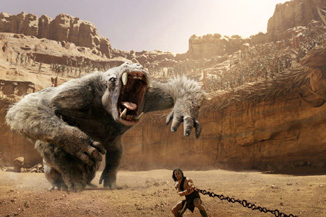Top 12 Film Industry Stories of 2012: #8
The Two Hundred Million Dollar Check
By David Mumpower
January 4, 2013
Have you ever written a check for $200 million? The odds are squarely against such a scenario. If you did, odds are much better that said check bounced. Only billionaires and corporate accountants can conceive of having to do so. Some faceless Disney employee in the office of Chief Financial Officer was tasked with such a strange assignment. The signature at the bottom of this check may as well have been “John Carter” because that name was to blame for Disney’s historic loss.
The fact that John Carter failed should not have been surprising. Hollywood has flirted with the idea of a cinematic adaptation as early as the 1930s. After the publication of A Princess of Mars as a serial in 1913 and then a novel in 1917, the Edgar Rice Burroughs concept became a literary franchise entitled Barsoom. By 1930, seven titles had already been released, making the title the Harry Potter franchise of its era.
A Princess of Mars is a science fiction staple, one of the seminal works of fiction of the 20th century. There is good reason to believe that an adaptation of the John Carter of Mars premise could become an iconic movie franchise. There is also ample reason to believe that any inevitable attempt to create a movie would fail.
For those of you have yet to see the movie – and judging by the box office, this is most of you – the world of Barsoom aka Mars is quite alien. The dominant natives of the planet are called the Tharks. This race is 15 feet tall on average and they have four arms each. Take a moment to imagine what a pre-CGI version of these creatures would have looked like. I presume it would be some weird combination of the original Clash of the Titans claymation and the ponytail look sported by Goro in Mortal Kombat.
Also, in a clever implementation of science and knowledge, Edgar Rice Burroughs deduced that the dense bone structure of mankind combined with the exponentially lower gravity of Mars would have a profound impact. The titular John Carter has the ability to soar into the sky as if Barsoom is one giant trampoline for the human race. A Princess of Mars is rich with imaginative ideas, none of which is particularly marketable. People don’t like to root for four-armed monsters. And a guy who can soar through the air is only interesting if there is a basketball goal somewhere in the vicinity.
Disney decided that their marketing wizardry was so polished that they could overcome such obstacles. After all, with Harry Potter ending, the marketplace was devoid of dominant franchises. By establishing the John Carter of Mars series, as many as a dozen potential films could be adapted. At a minimum, a couple could be produced before audiences grew tired of the concept.
This is the same playbook Disney used with The Lion, The Witch and The Wardrobe. Upon that title’s release in 2005, it quickly became one of the 20 most popular films of all time in terms of worldwide box office. The next two sequels quickly declined in value, something Disney execs anticipated. It was the rationale for their dropping the franchise after the second movie, leaving Fox holding the bag on The Voyage of the Dawn Treader. By that point, Disney had distributed two titles that grossed almost $1.2 billion. With global box office expanding so rapidly, a John Carter franchise could feasibly gross 50% more in two movies.
Continued:
1
2




